Themed collection Optical Biosensor Devices

Biosensing based on upconversion nanoparticles for food quality and safety applications
The unique optical properties of UCNPs, in particular the ability for background-free optical detection, bestow great potential for food safety and quality monitoring.
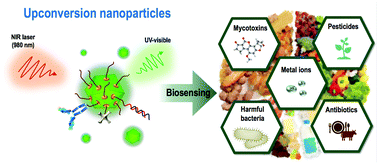
Analyst, 2021,146, 13-32
https://doi.org/10.1039/D0AN01883J
Light-responsive nanozymes for biosensing
Using light as an external stimulus plays a key role not only in modulating activities of nanozymes, but also in constructing efficient biosensing systems.
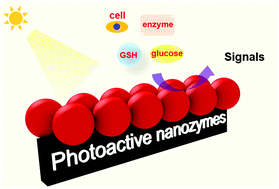
Analyst, 2020,145, 4388-4397
https://doi.org/10.1039/D0AN00389A
Nanomaterial-based multiplex optical sensors
Multiplexed detections based on optical nanomaterials.
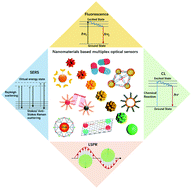
Analyst, 2020,145, 4111-4123
https://doi.org/10.1039/D0AN00392A
Recent advances in boronic acid-based optical chemosensors
This minireview highlights the developments in optical chemosensors from 2014 to 2016 that utilise the boronic acid interaction with polyols or Lewis bases.
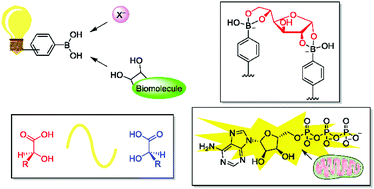
Analyst, 2017,142, 1403-1414
https://doi.org/10.1039/C7AN00439G
Single plasmonic nanoparticles as ultrasensitive sensors
In this mini review, we will provide a brief introduction focusing on the current applications of single plasmonic nanoparticle-based sensors using DFM, including the detection of molecules, the real-time monitoring of chemical/electrochemical reactions and the imaging of living cells.
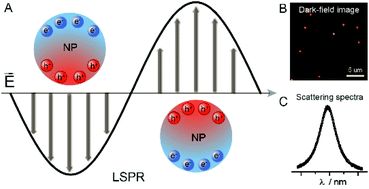
Analyst, 2017,142, 409-420
https://doi.org/10.1039/C6AN01852A
Recent advances of plasmonic nanoparticle-based optical analysis in homogeneous solution and at the single-nanoparticle level
Recent advances of plasmonic nanoparticle-based optical detection systems for various analytes in homogeneous solution and at the single-nanoparticle level are summarized.
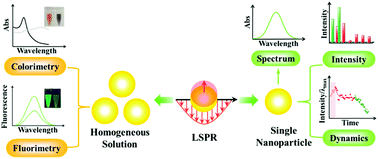
Analyst, 2020,145, 4737-4752
https://doi.org/10.1039/D0AN00609B
A new method to amplify colorimetric signals of paper-based nanobiosensors for simple and sensitive pancreatic cancer biomarker detection
Catalytic properties of gold nanoparticles in colour dye degradation are utilized to amplify colorimetric detection signals of a low-cost paper-based immunosensor for instrument-free detection of pancreatic cancer biomarker PEAK1.
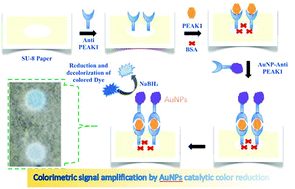
Analyst, 2020,145, 5113-5117
https://doi.org/10.1039/D0AN00704H
Rapid detection of mozzarella and feta cheese adulteration with cow milk through a silicon photonic immunosensor
Immunochemical detection of Mozzarella di Bufala Campana and Feta cheese adulteration with cow milk using integrated silicon Mach–Zehnder interferometers.
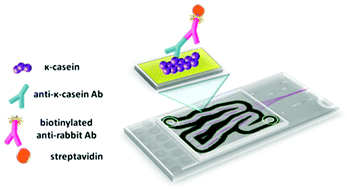
Analyst, 2021,146, 529-537
https://doi.org/10.1039/D0AN01706J
Ionophore-based pH independent detection of ions utilizing aggregation-induced effects
Here, aggregation-induced emission and quenching were incorporated for the first time in ionophore-based optical nanosensors.
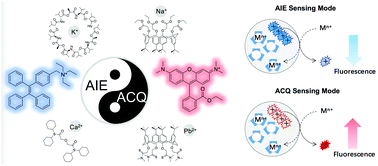
Analyst, 2020,145, 3846-3850
https://doi.org/10.1039/D0AN00486C
Widefield frequency domain fluorescence lifetime imaging microscopy (FD-FLIM) for accurate measurement of oxygen gradients within microfluidic devices
A widefield FD-FLIM system with fast acquisition speed is utilized to accurately characterize oxygen gradient distributions within microfluidic devices.
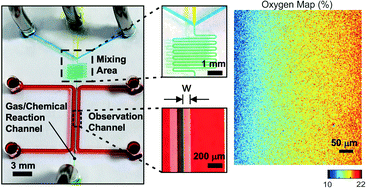
Analyst, 2019,144, 3494-3504
https://doi.org/10.1039/C9AN00143C
A novel turn-on fluorescent probe for selective sensing and imaging of glutathione in live cells and organisms
A novel 1-oxo-1H-phenalene-2,3-dicarbonitrile (OPD)-based fluorescent probe was developed to sense and image GSH in HeLa cells, different imatinib-resistant K562 cells, D. magna and zebrafish embryos.
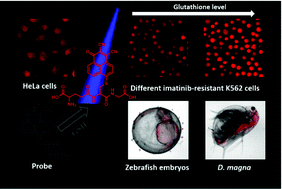
Analyst, 2019,144, 3260-3266
https://doi.org/10.1039/C9AN00115H
Excitation-independent emission carbon nanoribbon polymer as a ratiometric photoluminescent probe for highly selective and sensitive detection of quercetin
In this study, sulfur–nitrogen co-doped carbon nanoribbon (SNCNR) polymers with stable dual-emission fluorescence were synthesized using a one-step traditional hydrothermal method of 6-mercaptopurine in an aqueous methanol solution.
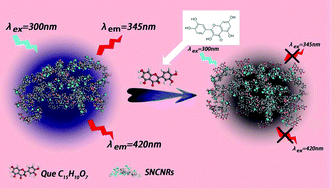
Analyst, 2019,144, 2256-2263
https://doi.org/10.1039/C9AN00094A
A novel fluorescent sensing platform based on metal-polydopamine frameworks for the dual detection of kanamycin and oxytetracycline
In this study, we report the dual detection of kanamycin (KMY) and oxytetracycline (OTC) using metal polydopamine frameworks (MPDA) for the first time.
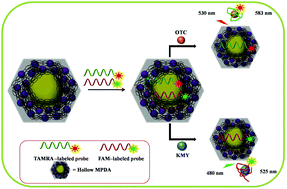
Analyst, 2019,144, 2337-2344
https://doi.org/10.1039/C8AN02363H
Detection of sulfadimethoxine using optical images of liquid crystals
An aptamer based liquid crystal biosensor was firstly developed for sulfadimethoxine detection achieving a lower detection limit of 10 μg L−1.
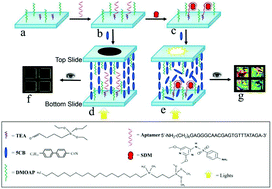
Analyst, 2019,144, 1761-1767
https://doi.org/10.1039/C8AN02049C
Reversible fluorescence modulation of BSA stabilised copper nanoclusters for the selective detection of protamine and heparin
Depicting fluorescence sensing of protamine and heparin based on aggregation and disaggregation of copper nanoclusters.
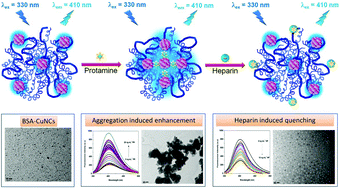
Analyst, 2019,144, 1799-1808
https://doi.org/10.1039/C8AN01703D
Electrogenerated chemiluminescence of black phosphorus nanosheets and its application in the detection of H2O2
Black phosphorus nanosheets (BPNS) were synthesized from BP crystals through liquid exfoliation coupled with ultrasonic methods under aqueous conditions.
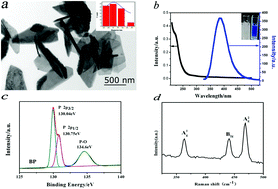
Analyst, 2019,144, 1326-1333
https://doi.org/10.1039/C8AN01838C
Facile fabrication of fluorescent Fe-doped carbon quantum dots for dopamine sensing and bioimaging application
A facile Fe-doped carbon quantum dot based fluorescent sensor for dopamine sensing and bioimaging was constructed.

Analyst, 2019,144, 656-662
https://doi.org/10.1039/C8AN01741G
Transition metal-coordinated graphitic carbon nitride dots as a sensitive and facile fluorescent probe for β-amyloid peptide detection
Herein, we developed a sensitive graphitic carbon nitride quantum dot (gCNQD)-based fluorescent strategy for β-amyloid peptide monomer (Aβ) determination down to the ng mL−1 level for the first time.
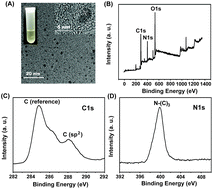
Analyst, 2019,144, 504-511
https://doi.org/10.1039/C8AN01620H
Thiol–ene click reaction-induced fluorescence enhancement by altering the radiative rate for assaying butyrylcholinesterase activity
A fluorescent molecular probe for assaying BChE activity based on thiol-triggered fluorescence enhancement via a thiol–ene click reaction was developed.
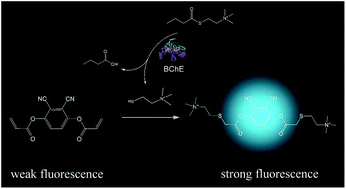
Analyst, 2019,144, 559-566
https://doi.org/10.1039/C8AN01808A
A highly selective naphthalimide-based ratiometric fluorescent probe for the recognition of tyrosinase and cellular imaging
Upon the addition of tyrosinase to the probe solution, the monophenolic unit is oxidized to o-dihydroxy and consequently releases the 4-aminonaphthalimide unit.
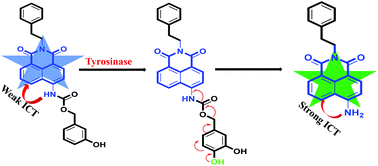
Analyst, 2018,143, 4476-4483
https://doi.org/10.1039/C8AN01136B
A fluorescent sensor based on aggregation-induced emission: highly sensitive detection of hydrazine and its application in living cell imaging
A fluorescent sensor based on aggregation-induced emission for amines was prepared and its highly sensitive detection of hydrazine and application in living cell imaging were investigated in detail.

Analyst, 2018,143, 4298-4305
https://doi.org/10.1039/C8AN00863A
A rainbow ratiometric fluorescent sensor array on bacterial nanocellulose for visual discrimination of biothiols
The crucial role of biothiols in many biological processes, which turns them into important biomarkers for the early diagnosis of various diseases, the development of an affordable, sensitive and portable probe for the detection and discrimination of these compounds is of great importance.
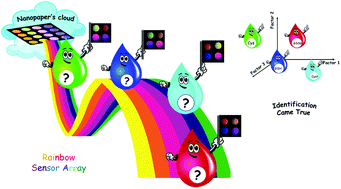
Analyst, 2018,143, 3415-3424
https://doi.org/10.1039/C8AN00637G
MoS2 nanohybrid as a fluorescence sensor for highly selective detection of dopamine
A simple and facile strategy is developed for the selective and sensitive detection of dopamine, using luminescent MoS2 nanohybrid particles.
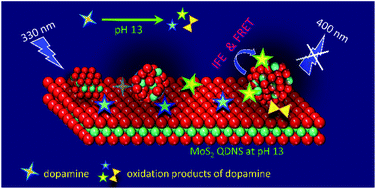
Analyst, 2018,143, 1691-1698
https://doi.org/10.1039/C7AN01770G
A tri-site fluorescent probe for simultaneous sensing of hydrogen sulfide and glutathione and its bioimaging applications
Hydrogen sulfide (H2S) and biothiol molecules, such as glutathione (GSH), cysteine (Cys), and homocysteine (Hcy), play an important role in biology.
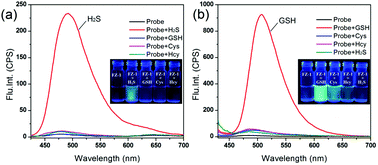
Analyst, 2018,143, 440-448
https://doi.org/10.1039/C7AN01588G
A ratiometric fluorogenic probe for the real-time detection of SO32− in aqueous medium: application in a cellulose paper based device and potential to sense SO32− in mitochondria
A new water soluble and fluorogenic probe (L) that can demonstrate the specific ratiometric detection of a SO2 derivative (SO32−) in 100% aqueous medium and live cells has been designed and synthesized.
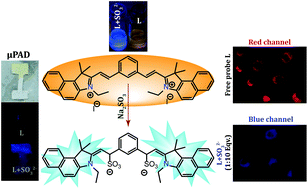
Analyst, 2018,143, 250-257
https://doi.org/10.1039/C7AN01368J
Functionalized gold nanoparticle-enhanced competitive assay for sensitive small-molecule metabolite detection using surface plasmon resonance
A functionalized gold nanoparticle-enhanced competitive assay was developed to overcome the sensitivity challenge associated with direct SPR sensing of small-molecule metabolites.
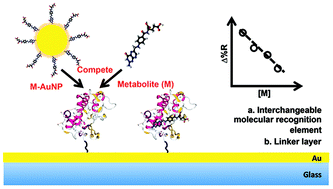
Analyst, 2018,143, 289-296
https://doi.org/10.1039/C7AN01680H
Excellent peroxidase mimicking property of CuO/Pt nanocomposites and their application as an ascorbic acid sensor
Functional CuO/Pt nanocomposites were successfully constructed as peroxidase mimics for highly selective colorimetric detection of ascorbic acid.
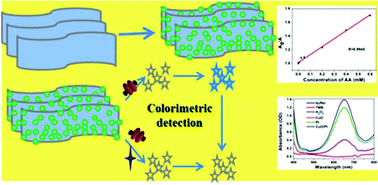
Analyst, 2017,142, 2500-2506
https://doi.org/10.1039/C7AN00589J
An ultrasensitive multi-walled carbon nanotube–platinum–luminol nanocomposite-based electrochemiluminescence immunosensor
An ultrasensitive electrochemiluminescence (ECL) immunosensor for carbohydrate antigen 19-9 (CA19-9) detection using multi-walled carbon nanotube–platinum–luminol nanocomposites (MWCNT–Pt–luminol) as nanointerface and signal tags was designed.
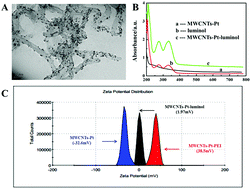
Analyst, 2017,142, 2253-2260
https://doi.org/10.1039/C7AN00417F
About this collection
A collection of papers and reviews on optical biosensor devices. Optical biosensors are based on the signal changes in UV/Vis and Infrared absorptions, fluorescence/luminescence emission or light scattering when chemical or biological reactions occur. Sensor devices such as lateral flow assay strips, microfluidic channels or microarrays are essential for miniaturised biosensor constructions. This collection covers recent developments in various sensor devices, combined with diverse optical detection methods.
This collection is guest edited by AnalystAssociate Editors Ryan Bailey (University of Michigan, USA), Jaebum Choo (Chung-Ang University, South Korea), Laura Lechuga (Catalan Institute of Nanoscience and Nanotechnology, Spain), Baohong Liu (Fudan University), and Advisory Board member Chaoyong James Yang (Xiamen University, China).